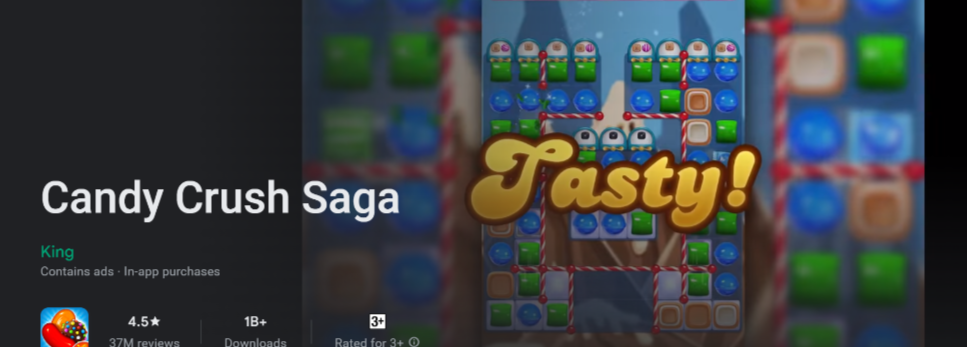
Candy Crush: The Sweet Saga of Mobile Gaming
In the world of mobile gaming, Candy Crush is a name that needs no introduction. Developed by King, a subsidiary of Activision Blizzard, Candy Crush is a puzzle game that has taken the mobile gaming industry by storm. With its addictive gameplay, colorful visuals, and hundreds of levels, Candy Crush has become a cultural phenomenon, captivating players of all ages and backgrounds. In this article, we’ll take a deep dive into the sweet world of Candy Crush, exploring its history, gameplay mechanics, impact on the gaming industry, and its enduring popularity.
The Birth of a Sweet Sensation
Candy Crush Saga, the first installment of the Candy Crush series, was released for mobile devices on April 12, 2012. The game was an instant hit, thanks to its simple yet engaging gameplay and vibrant graphics. Candy Crush’s success was built on the foundation of the match-3 puzzle genre, which involves swapping adjacent candies to form combinations of three or more of the same color.
The game’s premise is straightforward: players are tasked with completing various levels by achieving specific objectives, such as reaching a certain score, clearing a set number of candies, or freeing candies trapped in jelly or other obstacles. Candy Crush also introduced special candies and boosters, such as striped candies, wrapped candies, and color bombs, which added depth and strategy to the gameplay.
A Sweet Symphony of Gameplay
At its core, Candy Crush offers a deceptively simple gameplay experience that anyone can pick up and enjoy. However, as players progress through the levels, they encounter increasingly complex challenges that require careful planning and a keen eye for potential combinations. This gradual increase in difficulty keeps players engaged and motivated, making them want to continue playing to conquer the next level.
One of the game’s strengths is its accessibility. Candy Crush is designed to be easy to learn, with the first few levels serving as a tutorial to teach players the basic mechanics. This approach makes it welcoming to both casual gamers and those who may not have much experience with mobile gaming.
A World of Candy and Challenges
Candy Crush offers a staggering number of levels, each set in a different candy-themed world. These worlds include the Candy Kingdom, Chocolate Mountains, and Bubblegum Bridge, among others. The diversity of environments adds to the game’s visual appeal and keeps players excited to see what comes next.
To keep players engaged, King regularly releases updates with new levels and challenges, ensuring that there’s always something fresh for long-time players to enjoy. The game also features special events and limited-time challenges, adding an element of excitement and competition to the gameplay.
The Sweet Soundtrack of Success
Candy Crush’s success isn’t limited to its gameplay mechanics; its audio and visual design also play a significant role in its appeal. The game’s cheerful and catchy soundtrack, composed by Johan Holmström, perfectly complements the colorful visuals and gameplay. The satisfying sound effects that accompany each candy match and special candy activation contribute to the overall sense of gratification that players experience.
The Social Aspect of Candy Crushing
One of the key factors behind Candy Crush’s enduring popularity is its social integration. Players can connect the game to their Facebook accounts, allowing them to see their friends’ progress on the game’s map, send and receive lives, and compete for high scores. This social element adds a layer of friendly competition and encourages players to keep coming back to the game.
The Business of Sweet Success
Candy Crush’s freemium model, where the game is free to download and play but offers in-app purchases, has been instrumental in its financial success. Players can purchase boosters, extra lives, and other power-ups to help them overcome challenging levels or progress more quickly. The “freemium” approach has proven highly lucrative, and Candy Crush has consistently ranked as one of the top-grossing mobile games.
The Cultural Impact
Candy Crush has left an indelible mark on popular culture. It has been referenced in TV shows, movies, and even used as a metaphor for addiction and time-wasting in modern society. The game’s iconic candies, like the striped candy and color bomb, have become recognizable symbols to millions of players worldwide.
Candy Crush’s Legacy
As of my last knowledge update in September 2021, Candy Crush Saga remains a beloved and widely played mobile game. Its success has paved the way for numerous sequels and spin-off titles, including Candy Crush Soda Saga, Candy Crush Jelly Saga, and Candy Crush Friends Saga. The franchise’s enduring popularity has solidified its status as one of the most iconic and successful mobile game series of all time.
In conclusion, Candy Crush is not just a mobile game; it’s a cultural phenomenon that has brought joy and entertainment to millions of people around the world. Its addictive gameplay, charming design, and clever monetization strategies have made it a benchmark for mobile game success. While the mobile gaming landscape continues to evolve, Candy Crush remains a sweet reminder of the power of simplicity and accessibility in game design. Whether you’re a casual player looking to pass the time or a dedicated Candy Crusher aiming to conquer every level, one thing is certain: Candy Crush is here to stay, delighting players one candy at a time.